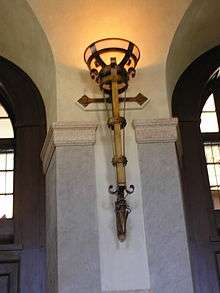Sconce (light fixture)
A sconce is a type of light fixture that is fixed to a wall. The light is usually, but not always, directed upwards and outwards, rather than down. The sconce is a very old form of fixture, historically used with candles and oil lamps. Modern fittings are more often called wall lights or similar terms, especially if the light source is wholly covered by glass.


They can provide general room lighting, and are common in hallways and corridors, but they may be mostly decorative.[1] A sconce may be a traditional torch, candle or gas light, or a modern electric light source affixed in the same way.
Usage and history
Sconces can be placed on both the interior and exterior walls of buildings. In pre-modern usage, these usually held candles and torches respectively. Historically, candle sconces were often made of silver or brass from the 17th century, with porcelain and ormolu coming into use during the 18th century. The light of the candle flame was often intensified by a reflecting backplate. Using brackets, the candle would be kept at safe distance from the wall.[2]
Modern electric light fixture sconces are often used in hallways or corridors to provide both lighting and a point of interest in a long passage. Sconce height in a passageway is generally 3/4 of the distance up the wall as measured from the floor to the ceiling, and the distance between sconces on the wall is generally equal to the distance of the sconces from the floor, often alternating sides of the passageway.
Sconces are typically installed in pairs or other multiple units to provide balance. They can be used to frame doorways or line a hallway. Swing-arm sconces are often placed next to a bed to provide task lighting for reading.
Footnotes
- https://web.archive.org/web/20171026184604/https://www.archtoolbox.com/materials-systems/electrical/lightfixtures.html
- "1430-Art Glass Wall Sconces". How It's Made. 2017.
| Wikimedia Commons has media related to Sconces. |
